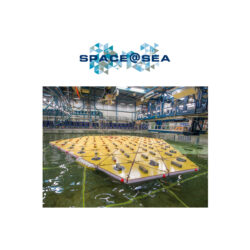Space@Sea: Demonstrator Design
Conceptualisation and Design exploration of Living@Sea is to explore how living space at sea can be accommodated on modular floating platforms which are used for multiple functions at sea. The starting point for the exploration is to consider modular triangular platforms. It is soon concluded that triangular shapes are an option, but from the perspective of spatial distribution and usable space, far less efficient compared to platforms based on a rectangular geometry (e.g. squares). Therefore, it is decided to change the module shape from triangle to square.
Based on a square module of 45 x 45 m, explorations of urban layouts, functions and architectural designs are carried out. A parametric model is set up, integrating multiple urban functions and exploring design alternatives. For Living@Sea, input is gathered from the analysis of land developments and comparing them to ones on water. Using the parametric model script, a design with 2,000 inhabitants is elaborated and visualized through artist impressions. An alternative design with 90 x 90 m platforms is also presented. Such design would be more optimal for locations such as the North Sea because of the sea states occurring. From the design exploration it can be concluded that a module of 45 x 45 m is suitable for the purpose of Living@Sea. Next to the design explorations, a general arrangement study and a weight analysis are
performed. For the Living@Sea reference design (45 x 45 module) a platform height of 10 to 11 m is estimated. This height is necessary to make sure connector points are above the water level. A preliminary analysis shows that the module meets the intact and damage stability requirements during transit.
To read more: Public deliverables: D7.3 – Demonstrator Design
